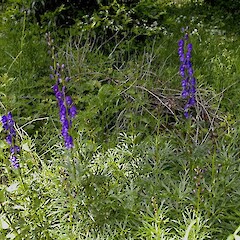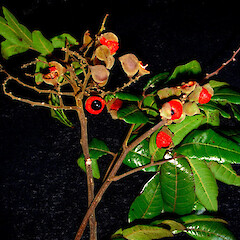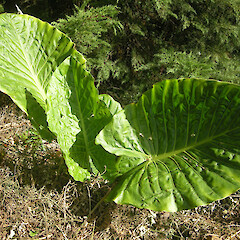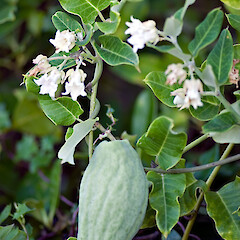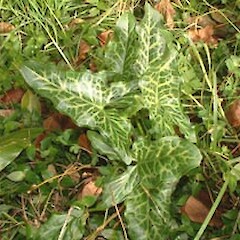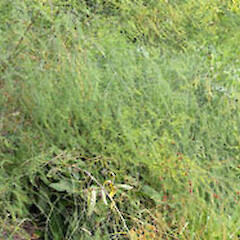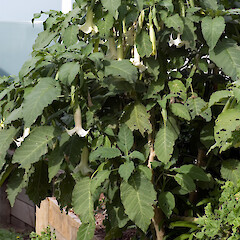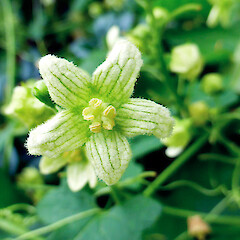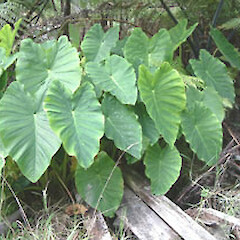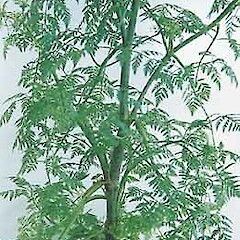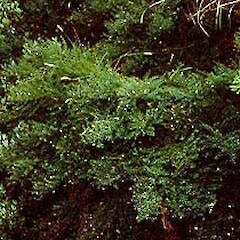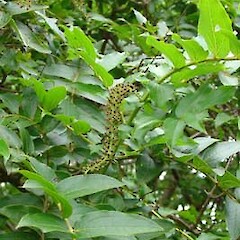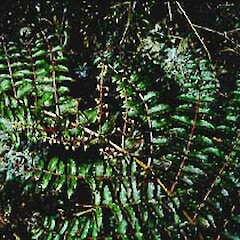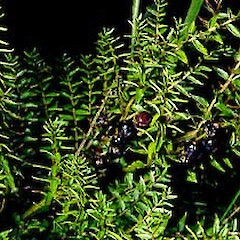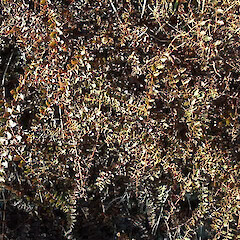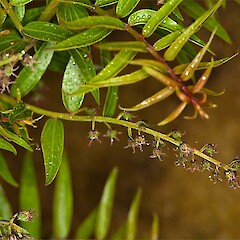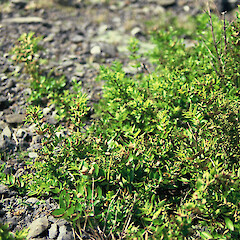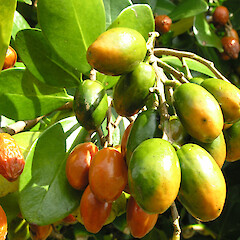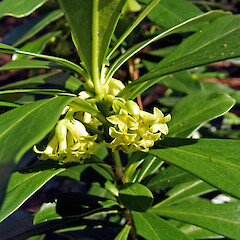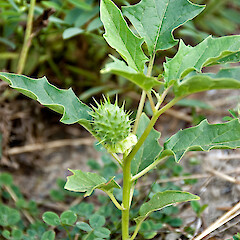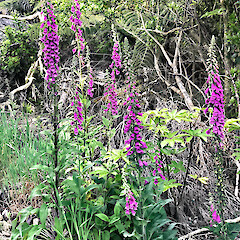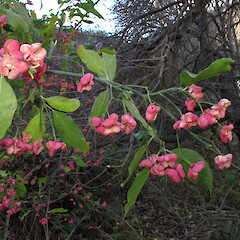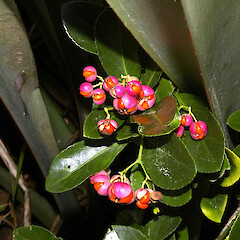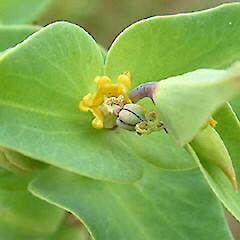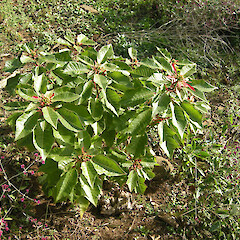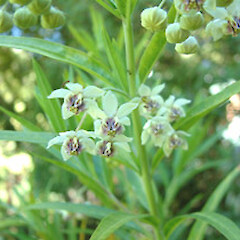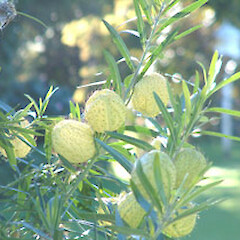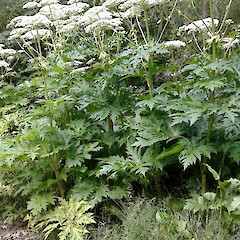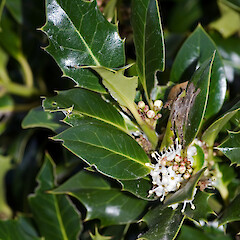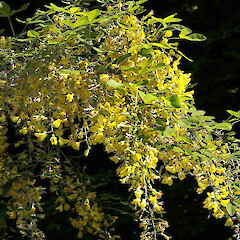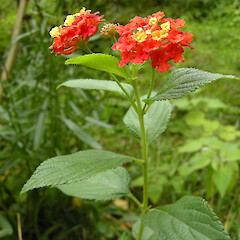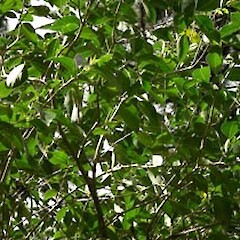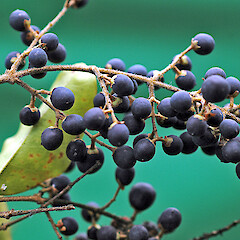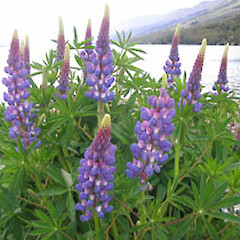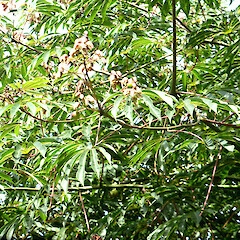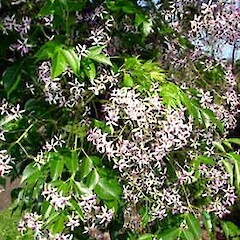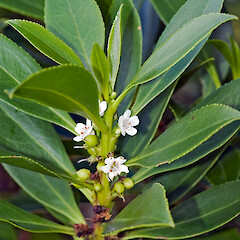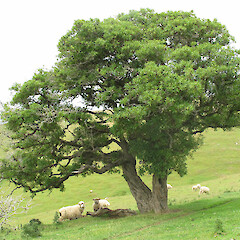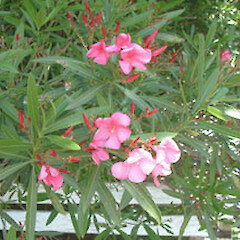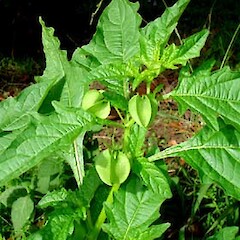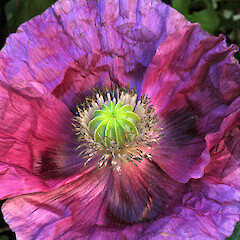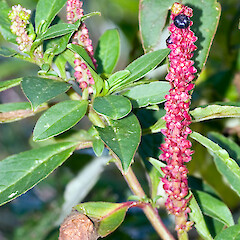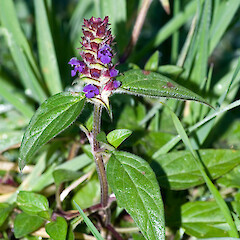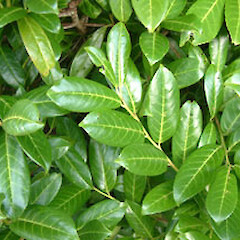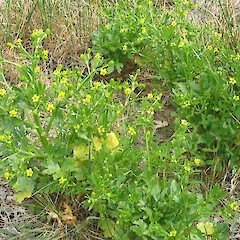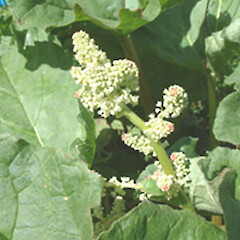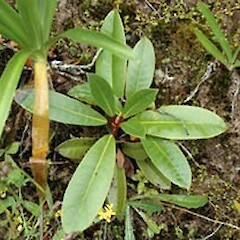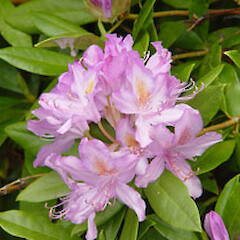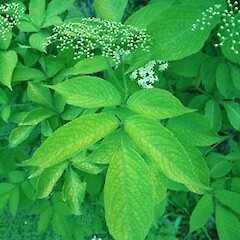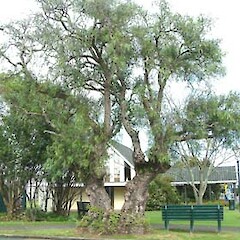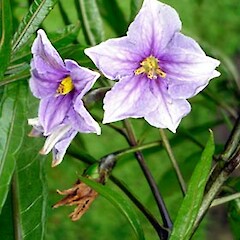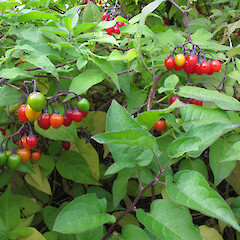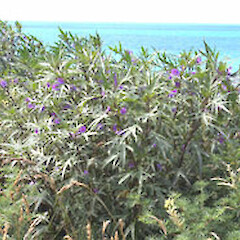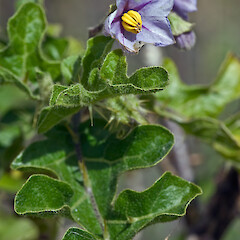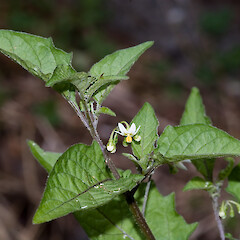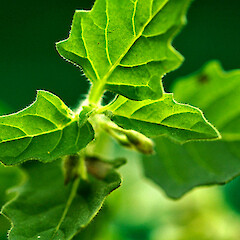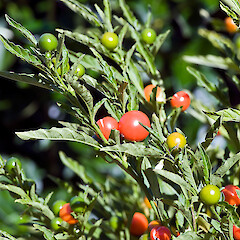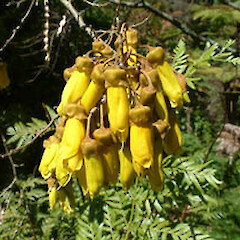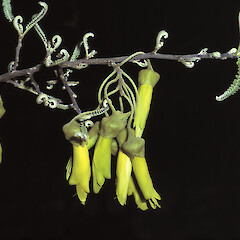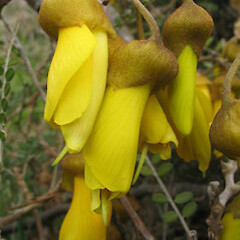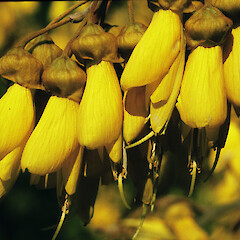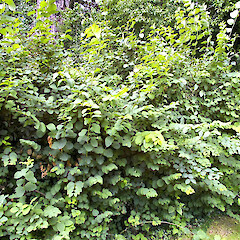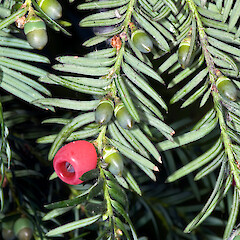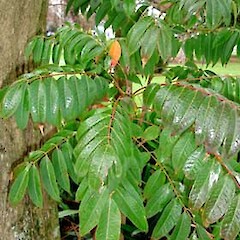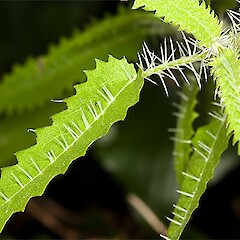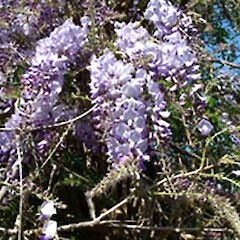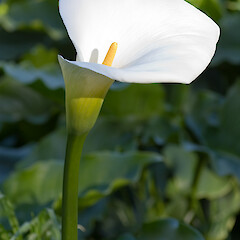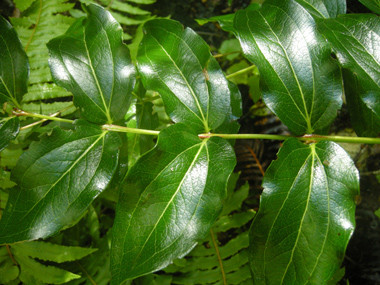 Coriaria arborea (tutu). Photo: John SawyerFor a poison emergency in New Zealand call 0800 POISON (0800 764 766) New Zealand National Poisons Centre.
Coriaria arborea (tutu). Photo: John SawyerFor a poison emergency in New Zealand call 0800 POISON (0800 764 766) New Zealand National Poisons Centre.
Many plants produce chemicals that are toxic to humans or other animals. These are often produced to protect the plant from browsing insects or mammals or from bacteria and fungi. In some cases the poisons protect the plant from competition with other plant species. Only rarely do these toxic chemicals affect humans but it is important to be able to recognise them so you can avoid using them in the garden and so you can educate your children not to eat them.
As foraging becomes more popular it is particularly important to be confident of correct plant identification before you eat something, especially since a lot of the online content about foraging is produced for European and American audiences with very different flora and often only using common names local to northern hemisphere audiences.
A range of native plants in New Zealand can be poisonous if not treated with caution, including: Coriaria spp. (8 species), karaka (Corynocarpus laevigatus), ngaio (Myoporum laetum), titoki (Alectryon excelsus) and ongaonga (Urtica ferox).
For more information see:
- Poisonous native plants (Te Ara - Encyclopedia of NZ)
- Henry Connor and John Fountain. 2009. Plants that poison - a New Zealand guide. Published by Manaaki Whenua Press.
- Poisonous plants in New Zealand (Landcare Research)
- Poisonous plants in New Zealand (RNZ Institute of Horticulture)
- Top 10 poisonous plants in New Zealand (National Poison Centre)
Below is a list of native and naturalised exotic plants in New Zealand which are known to be poisonous:
Aconitum napellus
Common name: monkshood, European monkshood, tiger’s bane, dog’s bane
Family: Ranunculaceae
Alectryon excelsus subsp. excelsus
Common name: New Zealand ash, tītoki
Family: Sapindaceae
Status: Not Threatened
Alocasia brisbanensis
Common name: elephant’s ears, aroid lily
Family: Araceae
Araujia hortorum
Common name: moth plant, moth vine
Family: Asclepiadaceae
Arum italicum
Common name: Italian arum
Family: Araceae
Asparagus officinalis
Common name: asparagus
Family: Asparagaceae
Brugmansia ×candida
Common name: angel’s trumpet
Family: Solanaceae
Bryonia cretica subsp. dioica
Common name: white bryony
Family: Cucurbitaceae
Catharanthus roseus
Common name: tropical periwinkle, Madagascar periwinkle
Family: Apocynaceae
Colocasia esculenta
Common name: Taro
Family: Araceae
Conium maculatum
Common name: hemlock
Family: Apiaceae
Coriaria angustissima
Common name: small-leaved tutu
Family: Coriariaceae
Status: Not Threatened
Coriaria arborea var. arborea
Common name: tutu, tree tutu
Family: Coriariaceae
Status: Not Threatened
Coriaria arborea var. kermadecensis
Common name: Kermadec tutu
Family: Coriariaceae
Status: At Risk – Naturally Uncommon
Coriaria kingiana
Common name: small-leaved tutu
Family: Coriariaceae
Status: Not Threatened
Coriaria plumosa
Common name: feathery tutu, mountain tutu, small-leaved tutu
Family: Coriariaceae
Status: Not Threatened
Coriaria pottsiana
Family: Coriariaceae
Status: At Risk – Naturally Uncommon
Coriaria pteridoides
Common name: small-leaved tutu
Family: Coriariaceae
Status: Not Threatened
Coriaria sarmentosa
Family: Coriariaceae
Status: Not Threatened
Corynocarpus laevigatus
Common name: karaka, kopi
Family: Corynocarpaceae
Status: Not Threatened
Cytisus scoparius
Common name: wild broom
Family: Fabaceae
Daphne laureola
Common name: spurge laurel
Family: Thymelaeaceae
Daphne oleoides
Family: Thymelaeaceae
Datura stramonium
Common name: thornapple
Family: Solanaceae
Digitalis purpurea
Common name: foxglove
Family: Plantaginaceae
Euonymus europaeus
Common name: spindle tree
Family: Celastraceae
Euonymus japonicus
Common name: Japanese spindleberry
Family: Celastraceae
Euphorbia lathyrus
Common name: caper spurge
Family: Euphorbiaceae
Euphorbia pulcherrima
Common name: poinsettia
Family: Euphorbiaceae
Gomphocarpus fruticosus
Common name: Swan plant, narrow leaf cotton bush
Family: Apocynaceae
Gomphocarpus physocarpus
Common name: Swan plant, balloon cotton bush
Family: Apocynaceae
Heracleum mantegazzianum
Common name: giant hogweed
Family: Apiaceae
Hypericum perforatum
Common name: St John’s wort
Family: Hypericaceae
Ilex aquifolium
Common name: holly
Family: Aquifoliaceae
Iris foetidissima
Common name: stinking iris
Family: Iridaceae
Laburnum anagyroides
Common name: golden chain
Family: Fabaceae
Lantana camara var. aculeata
Common name: lantana
Family: Verbenaceae
Ligustrum lucidum
Common name: tree privet
Family: Oleaceae
Ligustrum ovalifolium
Common name: privet
Family: Oleaceae
Ligustrum sinense
Common name: Chinese privet
Family: Oleaceae
Ligustrum vulgare
Common name: common privet
Family: Oleaceae
Lupinus arboreus
Common name: tree lupin
Family: Fabaceae
Lupinus polyphyllus
Common name: Russell lupin
Family: Fabaceae
Lycium ferocissimum
Common name: boxthorn
Family: Solanaceae
Manihot grahamii
Common name: Hardy tapioca
Family: Euphorbiaceae
Melia azedarach
Common name: Melia
Family: Meliaceae
Myoporum aff. insulare
Common name: Tasmanian ngaio, boobialla
Family: Scrophulariaceae
Myoporum laetum
Common name: ngaio
Family: Scrophulariaceae
Status: Not Threatened
Nerium oleander
Common name: oleander
Family: Apocynaceae
Nicandra physalodes
Common name: apple of Peru
Family: Solanaceae
Papaver nudicaule
Common name: Iceland poppy
Family: Papaveraceae
Papaver somniferum subsp. somniferum
Common name: opium poppy
Family: Papaveraceae
Phytolacca octandra
Common name: inkweed
Family: Phytolaccaceae
Prunella vulgaris
Common name: self-heal
Family: Lamiaceae
Prunus laurocerasus
Common name: cherry laurel
Family: Rosaceae
Ranunculus sceleratus
Common name: celery-leaved buttercup
Family: Ranunculaceae
Rheum ×rhabarbarum
Common name: rhubarb
Family: Polygonaceae
Rhododendron arboreum
Family: Ericaceae
Rhododendron ponticum subsp. ponticum
Common name: rhododendron
Family: Ericaceae
Ricinus communis
Common name: castor oil plant
Family: Euphorbiaceae
Sambucus nigra
Common name: elder, elderflower, elderberry
Family: Adoxaceae
Schinus molle
Common name: Pepper tree
Family: Anacardiaceae
Solanum aviculare var. aviculare
Common name: poroporo
Family: Solanaceae
Status: Threatened – Nationally Vulnerable
Solanum diflorum
Common name: false Jerusalem cherry
Family: Solanaceae
Solanum dulcamara
Common name: bittersweet
Family: Solanaceae
Solanum laciniatum
Common name: poroporo, bullibulli
Family: Solanaceae
Status: Not Threatened
Solanum linnaeanum
Common name: apple of Sodom
Family: Solanaceae
Solanum mauritianum
Common name: woolly nightshade
Family: Solanaceae
Solanum nigrum
Common name: black nightshade
Family: Solanaceae
Solanum nitidibaccatum
Common name: hairy nightshade
Family: Solanaceae
Solanum pseudocapsicum
Common name: Jerusalem cherry
Family: Solanaceae
Sophora chathamica
Common name: kōwhai, coastal kōwhai
Family: Fabaceae
Status: Not Threatened
Sophora fulvida
Common name: kōwhai
Family: Fabaceae
Status: At Risk – Naturally Uncommon
Sophora microphylla
Common name: kōwhai, weeping kōwhai, small-leaved kōwhai
Family: Fabaceae
Status: Not Threatened
Sophora tetraptera
Common name: kōwhai, large-leaved kōwhai
Family: Fabaceae
Status: Not Threatened
Symphoricarpos albus
Common name: snowberry bush
Family: Caprifoliaceae
Taxus baccata
Common name: yew
Family: Taxaceae
Toxicodendron succedaneum
Common name: Japanese wax-tree
Family: Anacardiaceae
Urtica ferox
Common name: ongaonga, tree nettle
Family: Urticaceae
Status: Not Threatened
Wisteria sinensis
Common name: Wisteria
Family: Fabaceae
Zantedeschia aethiopica
Common name: arum lily
Family: Araceae

